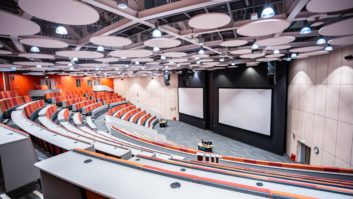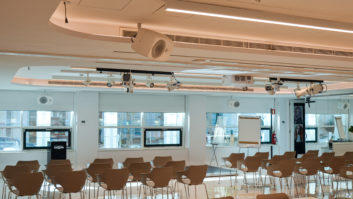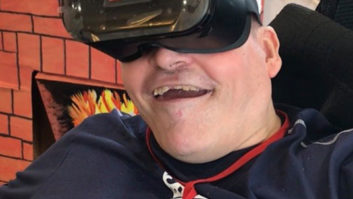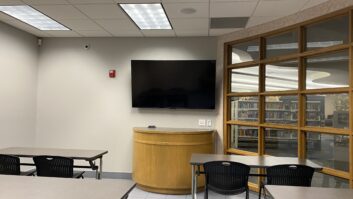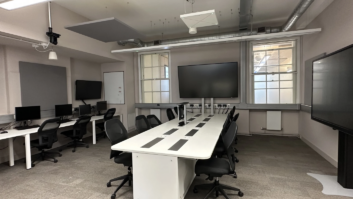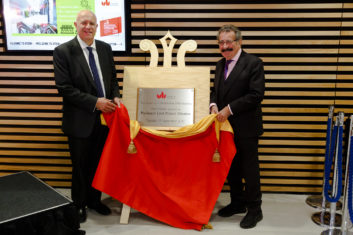 The University of Bedfordshire’s £40 million STEM (science, technology, engineering and mathematics) building brings over 6,000 square metres of new teaching space to the University. Dedicated to the pursuit of STEM subjects, it has enabled the university to increase its undergraduate community and facilitate the latest STEM teaching and research methods.
The University of Bedfordshire’s £40 million STEM (science, technology, engineering and mathematics) building brings over 6,000 square metres of new teaching space to the University. Dedicated to the pursuit of STEM subjects, it has enabled the university to increase its undergraduate community and facilitate the latest STEM teaching and research methods.
The £500,000 audiovisual project was completed by Pure AV and included the installation and commissioning of 14 spaces consisting of labs, standard classrooms, collaboration spaces and speciality rooms.
Key project objectives were to grow student numbers, improve facilities for STEM academics and provide students a modern, collaborative learning environment. The University’s IT department wanted uniformity in the digital infrastructure, which meant switching to laser projection, embracing AV over IP (AVoIP), and facilitating BYOD.
The AV systems created are scaleable, future-proofed and simple to use. The project utilises AVoIP and networked audio to maximise the flexibility of teaching delivery and the available teaching space.
The solution
The new building contains wet & dry labs, computer labs, standard classrooms, collaboration spaces and specialised rooms. Many spaces are large, open areas containing specialised technical equipment.
Laser projection and high definition displays are carefully placed to ensure students maintain a clear view of the teaching activity, while the audio system delivers precise audio reproduction from microphones and programme sound.
Each teaching space contains multiple display devices ranging from a couple of projectors up to eight or nine LED displays or a combination of LED screens and projectors. Using Wyrestorm AVoIP, each display is connected to the university network.
There is no fixed teaching point in the labs. Instead, a mobile lectern can be wheeled about and located in one of up to four or six connection points, depending on lab size.
The use of AVoIP means that the roving lecterns can be quickly joined to the network via a single cable connection into a network socket. The academic can then commence teaching either by linking a laptop to the connection plate or through use of the in-built PC.
Connection of the lectern is straightforward. Bespoke network connection plates are labelled, and cables are colour coded so that lecturers can immediately see the correct cable to insert. Simple Extron push-button controllers are used to manage source switching.
In the large teaching labs, Shure array microphones ensure that both student and teachers are heard without difficulty. These labs can operate as two separate rooms or combine to become one space with the option for master control from either place.
Each contains a total of three Epson laser projectors and three Shure MXA910 ceiling-mounted conference microphone systems and mobile lecterns. The system feeds into a central DSP and is programmed so that the ceiling speakers near to the person speaking do not output the audio.
When labs are to be linked together, the university technicians can use the Wyrestorm App to drag and drop and adjust the system layout effortlessly.
The design of the building places most of the mechanical electrics and data above a series of floating panels. The University enlisted the engineering skills of Pure AV system designer Dan Saville, CTSD, CTS-I to calculate precise positions for ceiling-mounted devices.
There were instances where construction had varied from plan and Saville was able to provide practical solutions to work around the changes. In two of the impacted areas, he value-engineered a solution that avoided the need for additional cost and in fact offered a saving from the original budget.
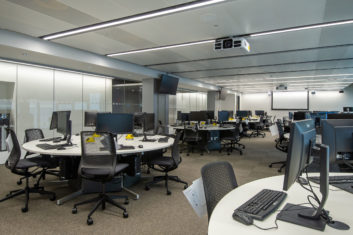
The project has successfully utilised AVoIP and networked audio to maximise the flexibility of teaching delivery and the available teaching space. The implementation of the roving lecterns enables lecturers to teach from multiple positions and select the best location to suit the class size and teaching objectives.
The university’s IT team now have “an infrastructure that is robust and ready to expand to accommodate new and emerging technologies”, according to Pure AV. The management of the teaching spaces has been simplified enabling more effective management of the spaces. Lamp-free projection systems have reduced the cost of consumables and meet the requirements of the university’s environmental targets.
The facilities have enabled the University to offer an increased number of students access to high-quality learning environments in the critical area of STEM-based education.
The project has allowed the University’s ICT department through collaboration with Pure AV to design and produce a solution that has brought uniformity to its digital infrastructure and creates an AV standard that will shape the University’s classroom designs in the future.
“Investing in technology on the cutting edge of their fields is vital to the student experience at Bedfordshire. The technology we use allows students to experience industry-level practices and gain the skills necessary to attain these new knowledge bases for their future careers,” said Bill Rammel, vice-chancellor, University of Bedfordshire.
“The STEM building serves as an icon for the town, symbolising our commitment to skills, scientific discovery and an unimaginable future. Our goal is not simply to help our students achieve a degree, but to prepare them for their future and help them achieve their aims and ambitions. The STEM facilities give students the opportunity to develop their skills and knowledge to be able to enter the world of work prepared and practiced in their fields.”
